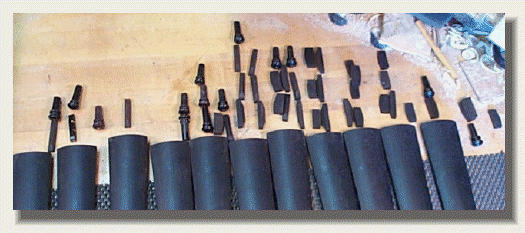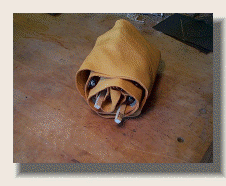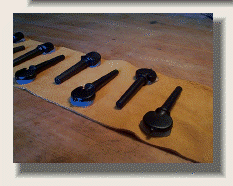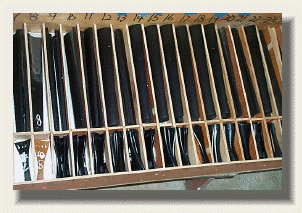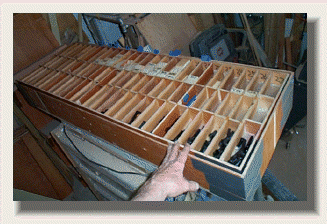Rub Tone/ Wood Tone Musical Scale....
Modified 12/2020
(Page VRT_3/13)
. To make up a standard scale of 'rub tones', I devised this method, selecting tuning pegs to represent the (24) different apparent 'rub tones' so that I now have a permanent reference I can use to sort future parts. I used a strip of deer skin and attached the sorted parts with clear GE silicone calking which keeps the parts in order and makes it easy to stroke the samples to hear their 'rub tones':
.. Of this range of 24 audible rub tones, # 22 tests the best sound generated when comparison tapped, with sound deteriorating in both directions from #22, equally.
Above Right: Notice how nicely it all rolls up for storage.
Silicone.
...Next, I needed to make some bins to put sort the pieces necessary for violin making by 'rub tone', requiring 27 different bins and enough compartments to hold the different parts. I designed this nested box with a removable top section that lifts out revealing lower compartments:
# 4Rub
Tone
#22 Rub
Tone
#27 Rub
Tone
...With the introduction of the idea of 'rub tone' as in important instrument making topic, I wondered what the range of 'rub tones' might be for the various wood parts of the violin family instruments.
...I had purchased a good stock of ebony wood fittings from a firm in India and taking eighty or so wood parts out began to sort them in a line based on their 'rub tone'. Beginning with the (30) fingerboards and tailpieces, the brighter, more responsive parts were moved to the right and the duller, less responsive ''rub tone' pieces were sorted to the left. The results are shown in the photo below:
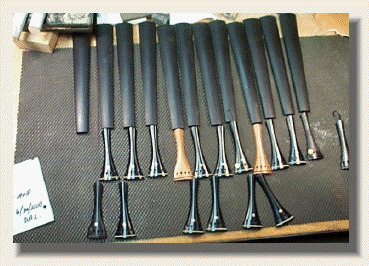
...Notice that of the (12) seemingly identical first quality ebony fingerboards, no two had the same 'rub tone' and they covered quite a wide range, being evenly spread out!
...Of the (18) ebony and box wood tailpieces only two had the same 'rub tone'
Where the tailpiece and fingerboard touch, these were the same 'rub tone' (and thus should be paired together on a future instrument); where the bottom row of tail pieces are shifted, these are a 'rub tone' in between the middle row tailpieces.
...Next I added the nut, saddle, and end pin ebony parts I had on hand and sorted them as above by 'rub tone', placing them in their relative positions:
..The sound analysis of the desired ( range # 21 -- # 23) Rub Tones {FFT frequency analysis} :
..
- # 21 Rub Tone......................... 790 HZ
- #21 1/2 Rub Tone................... 821 HZ
- # 22 Rub Tone..........................861 HZ
- # 23 Rub Tone..........................893 HZ
<<Notice that (861 HZ ), the ideal #22 rub tone, is exactly three times 187 HZ, which IS on the "Tap Tone" scale.>>
